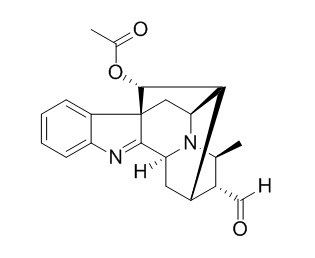Perakine
Standard reference
Inquire / Order:
manager@chemfaces.com
Technical Inquiries:
service@chemfaces.com
Tel:
+86-27-84237783
Fax:
+86-27-84254680
Address:
1 Building, No. 83, CheCheng Rd., Wuhan Economic and Technological Development Zone, Wuhan, Hubei 430056, PRC
Providing storage is as stated on the product vial and the vial is kept tightly sealed, the product can be stored for up to
24 months(2-8C).
Wherever possible, you should prepare and use solutions on the same day. However, if you need to make up stock solutions in advance, we recommend that you store the solution as aliquots in tightly sealed vials at -20C. Generally, these will be useable for up to two weeks. Before use, and prior to opening the vial we recommend that you allow your product to equilibrate to room temperature for at least 1 hour.
Need more advice on solubility, usage and handling? Please email to: service@chemfaces.com
The packaging of the product may have turned upside down during transportation, resulting in the natural compounds adhering to the neck or cap of the vial. take the vial out of its packaging and gently shake to let the compounds fall to the bottom of the vial. for liquid products, centrifuge at 200-500 RPM to gather the liquid at the bottom of the vial. try to avoid loss or contamination during handling.
Food Analytical Methods2020, 1-10
Phytomedicine.2024, 126:155442.
Analytical Methods2018, 10(27)
Plant Sci.2020, 301:110656.
Int J Mol Sci.2019, 20(23):E6071
Genes (Basel).2021, 12(7):1024.
Molecules.2021, 26(16):4722.
Pharmaceuticals (Basel).2020, 13(9):262.
Pharmaceuticals (Basel).2021, 14(6):588.
Int J Mol Sci.2023, 24(15):12397.
Related and Featured Products
Plant Mol Biol. 2008 Jul;67(5):455-67.
Purification, cloning, functional expression and characterization of perakine reductase: the first example from the AKR enzyme family, extending the alkaloidal network of the plant Rauvolfia.[Pubmed:
18409028]
Perakine reductase (PR) catalyzes an NADPH-dependent step in a side-branch of the 10-step biosynthetic pathway of the alkaloid ajmaline.
METHODS AND RESULTS:
The enzyme was cloned by a "reverse-genetic" approach from cell suspension cultures of the plant Rauvolfia serpentina (Apocynaceae) and functionally expressed in Escherichia coli as the N-terminal His(6)-tagged protein. PR displays a broad substrate acceptance, converting 16 out of 28 tested compounds with reducible carbonyl function which belong to three substrate groups: benzaldehyde, cinnamic aldehyde derivatives and monoterpenoid indole alkaloids. The enzyme has an extraordinary selectivity in the group of alkaloids. Sequence alignments define PR as a new member of the aldo-keto reductase (AKR) super family, exhibiting the conserved catalytic tetrad Asp52, Tyr57, Lys84, His126. Site-directed mutagenesis of each of these functional residues to an alanine residue results in >97.8% loss of enzyme activity, in compounds of each substrate group.
CONCLUSIONS:
PR represents the first example of the large AKR-family which is involved in the biosynthesis of plant monoterpenoid indole alkaloids. In addition to a new esterase, PR significantly extends the Rauvolfia alkaloid network to the novel group of peraksine alkaloids.
J Biol Chem. 2012 Mar 30;287(14):11213-21.
Crystal structure of perakine reductase, founding member of a novel aldo-keto reductase (AKR) subfamily that undergoes unique conformational changes during NADPH binding.[Pubmed:
22334702]
METHODS AND RESULTS:
Perakine reductase (PR) catalyzes the NADPH-dependent reduction of the aldehyde Perakine to yield the alcohol raucaffrinoline in the biosynthetic pathway of ajmaline in Rauvolfia, a key step in indole alkaloid biosynthesis. Sequence alignment shows that PR is the founder of the new AKR13D subfamily and is designated AKR13D1. The x-ray structure of methylated His(6)-PR was solved to 2.31 Å. However, the active site of PR was blocked by the connected parts of the neighbor symmetric molecule in the crystal. To break the interactions and obtain the enzyme-ligand complexes, the A213W mutant was generated. The atomic structure of His(6)-PR-A213W complex with NADPH was determined at 1.77 Å.
CONCLUSIONS:
Overall, PR folds in an unusual α(8)/β(6) barrel that has not been observed in any other AKR protein to date. NADPH binds in an extended pocket, but the nicotinamide riboside moiety is disordered. Upon NADPH binding, dramatic conformational changes and movements were observed: two additional β-strands in the C terminus become ordered to form one α-helix, and a movement of up to 24 Å occurs. This conformational change creates a large space that allows the binding of substrates of variable size for PR and enhances the enzyme activity; as a result cooperative kinetics are observed as NADPH is varied. As the founding member of the new AKR13D subfamily, PR also provides a structural template and model of cofactor binding for the AKR13 family.
Natural Product Research & Development,2007,19 (10) :235-239.
Indole Alkaloids from Rauwolfia vomitoria[Reference:
WebLink]
Fifteen indole alkaloids were isolated from the roots of Rauwolfia vomitoria.
METHODS AND RESULTS:
On the basis of spectroscopic evidence, their structures were identified as reserpine (1), tetrahydroalstonine (2), isosandwicine (3), methyl reserpate (4) ,ajmaline (5) , sandwicine (6) ,isorauhimbine (7) , Perakine (8) , α-yohimbine (9) , yohimbine (10) , mitoridine (11) ,tetraphyllicine (12), harman (13) ,mauiensine (14), and 12-hydroxymauiensine (15). Compounds 13 aˆ¼ 15 were isolated from this plant for the first time.



